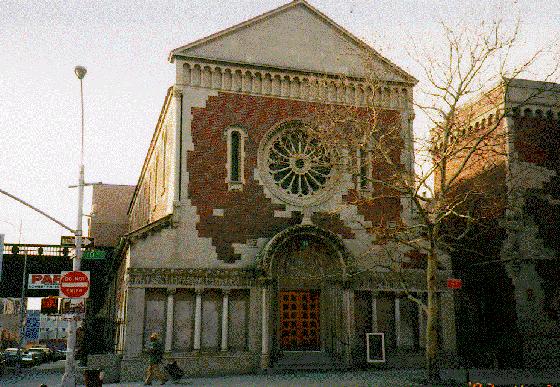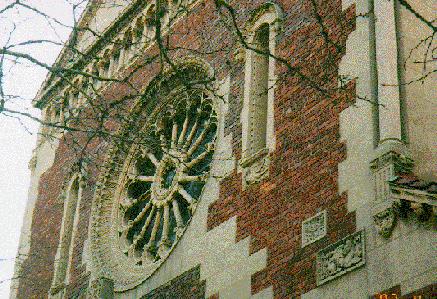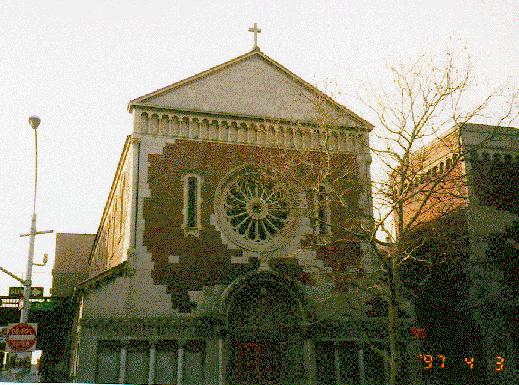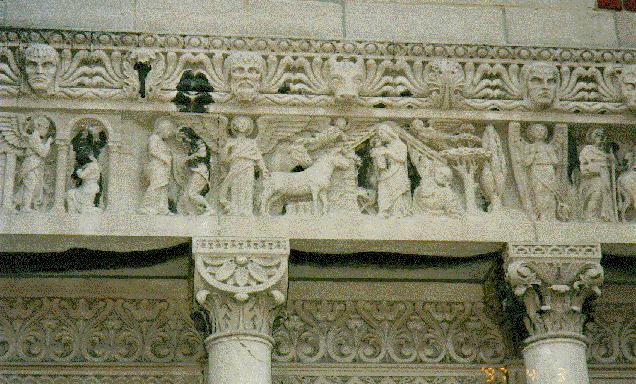The Church of the Guardian Angel
 |
(Roman Catholic)
193 W.21st Street at 10th Avenue
by Wendy Plaut
|
"The church's simple brick and limestone Southern Sicilian Romanesque
facade merges with the Tuscan village forms of auxiliary buildings to the
north in a well- related group." (AIA Guide to NYC, p.175)
History
Early historians of medieval art followed a similar pattern. To them, the
great climax was the Gothic style, from the thirteenth century to the fifteenth.
For whatever was not-yet-Gothic they adopted the label Romanesque. In doing
so, they were thinking mainly of architecture. Pre-Gothic churches, they
noted, were round-arched, solid, and heavy, as against the pointed arches
and the soaring lightness of Gothic structures. It was rather like the
ancient Roman style of building, and the term "Romanesque" was meant to
convey just that. In this sense, all of medieval art before 1200 could
be called Romanesque insofar as it shows any link with the Mediterranean
tradition. |
 |
 |
Architecture
The most conspicuous difference between Romanesque architecture and that
of the preceding centuries is the amazing increase in building activity.
An eleventh century monk, Raoul Glaber, summed it up well when he triumphantly
exclaimed that the world was putting on a "white mantle of churches." These
churches were not only more numerous than those of the early Middle Ages,
they were also generally larger, more richly articulated, and more "Roman-looking."
Their naves now had vaults instead of wooden roofs, and their exteriors,
unlike those of early Christian, Byzantine, Carolingian, and Ottonian churches,
were decorated with both architectural ornament and sculpture. Geographically,
Romanesque monuments of the first importance are distributed over an area
that might well have represented the world- the Catholic world |
|
|
|
|
Interesting Facts
- The Church of the Guardian Angel is reminiscent of the early Romanesque
sculpture at the abbey of Moissac. Both churches have a scalloped profile
that seems to incorporate a bit of Moorish influence. Both the human and
animal forms are treated with the same incredible flexibility. The purpose
of this carefully illustrated art work is not only decorative but expressive.
They embody dark forces that have been domesticated into guardian figures
or banished to a position that holds then fixed for all eternity.
- The portal proper at the church is preceded by a deep porch, with lavishly
sculptured sides. It is adorned with events from the early life of Christ.
Only the proportions of the bodies and the size of the figures vary with
the architectural context. What matters is the vividness of the narrative,
rather than consistency of treatment.
- The Church of the Guardian Angel was built in the 1930s by John Van
Pelt.

Works Cited
- The Dictionary of Art. Edited by Jane Turner. Volume #23. Macmillan,
New York, 1996.
- AIA Guide to New York City. Elliot Willensky and Norval White.
3rd Edition. Harcourt Brace Jovanovich Publishers: New York,
1988.
Back
to Medieval New York
The Internet History Sourcebooks Project is located at the History Department of Fordham University, New York. The Internet
Medieval Sourcebook, and other medieval components of the project, are located at
the Fordham University Center
for Medieval Studies.The IHSP recognizes the contribution of Fordham University, the
Fordham University History Department, and the Fordham Center for Medieval Studies in
providing web space and server support for the project. The IHSP is a project independent of Fordham University. Although the IHSP seeks to follow all applicable copyright law, Fordham University is not
the institutional owner, and is not liable as the result of any legal action.
© Site Concept and Design: Paul Halsall created 26 Jan 1996: latest revision 12 April 2024 [CV]
|